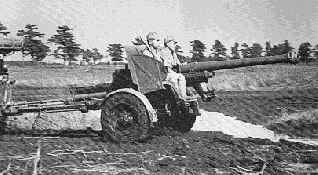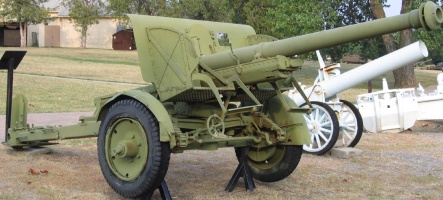Type 90 (75 mm)
| This page is about the Japanese tank cannon Type 90 (75 mm). For other uses, see Type 90 (Disambiguation). |
Contents
Description
The Type 90 75 mm is a Japanese field gun adopted in 1930 meant to replace the older Type 38 75 mm. The field gun was initially built like a traditional field gun but later would be remodeled to be mobile so that could be towed by vehicle. It also saw limited use on the Ho-Ni I and would lay the basis for the Type 3 75 mm tank gun which would be primarily mounted in the Ho-Ni III and Chi-Nu.
Vehicles equipped with this weapon
General info
Tell us about the tactical and technical characteristics of the cannon or machine gun.
Available ammunition
| Penetration statistics | |||||||
|---|---|---|---|---|---|---|---|
| Ammunition | Type of warhead |
Penetration @ 0° Angle of Attack (mm) | |||||
| 10 m | 100 m | 500 m | 1,000 m | 1,500 m | 2,000 m | ||
| Type 1 APHE | APHE | 103 | 101 | 92 | 82 | 73 | 65 |
| Type 94 HE | HE | 12 | 12 | 12 | 12 | 12 | 12 |
| Shell details | |||||||||
|---|---|---|---|---|---|---|---|---|---|
| Ammunition | Type of warhead |
Velocity (m/s) |
Projectile Mass (kg) |
Fuse delay (m) |
Fuse sensitivity (mm) |
Explosive Mass (TNT equivalent) (g) |
Ricochet | ||
| 0% | 50% | 100% | |||||||
| Type 1 APHE | APHE | 668 | 6.56 | 1.3 | 15 | 84.8 | 47° | 60° | 65° |
| Type 94 HE | HE | 522 | 6.02 | 0 | 0.1 | 810 | 79° | 80° | 81° |
| Smoke shell characteristics | ||||||
|---|---|---|---|---|---|---|
| Ammunition | Velocity (m/s) |
Projectile Mass (kg) |
Screen radius (m) |
Screen deploy time (s) |
Screen hold time (s) |
Explosive Mass (TNT equivalent) (g) |
| Type 90 Smoke | 570 | 5.72 | 13 | 5 | 20 | 100 |
Comparison with analogues
Give a comparative description of cannons/machine guns that have firepower equal to this weapon.
Usage in battles
Describe the cannon/machine gun in the game - its distinctive features, tactics of usage against notable opponents. Please don't write a "guide" - do not impose a single point of view, but give the reader food for thought.
Pros and cons
Summarise and briefly evaluate the weaponry in terms of its characteristics and combat effectiveness. Mark pros and cons as a list.
Pros:
Cons:
History
In the aftermath of World War I, the Japanese sought to modernize their inventory of artillery weapons, which mainly consisted of the 75 mm Type 38 field gun. A new field artillery design utilizing the new autofrettage manufacturing method was desired and so the Japanese went to the Schneider company in 1925 to acquire the license to be able to obtain the equipment needed for this manufacturing method. During the visit, the Japanese also acquired batches of Schneider 75 mm field guns and 105 mm field howitzers for trials.[1]
Around the same time, a Colonel Saigo from the Technical Department's artillery office, in cooperation with the Osaka Arsenal, designed a 75 mm field gun for use. Its characteristics were comparable to the Schneider's 75 mm field gun, and so the two underwent comparative trials in April 1927. The result was mixed as both guns have their praise and complaints. The decision was made for parts of the Schneider gun to be license-produced in Japan while incorporating their own design requirements in the weapon, including the retention of a Krupp-type horizontal breech seen on the Type 38 field gun. The completed assembled weapon was designated the 75 mm Type 90 field gun in 1930.[2]
A total of 786 of the Type 90 field guns were produced from 1931 to 1944.[2][3] Two variants of the 75 mm Type 90 gun was produced, one with a horse-drawn carriage with wooden wheels (221 produced[2]), and another with a stronger suspension and rubber wheels for motor vehicle towing.[3][4] The motorized variant began seeing production in 1935-36, but an attempt was made in 1935 to replace the Type 90 with the more lightweight 75 mm Type 95 field gun (which used the Type 38's barrel and ordnance), briefly stopping the Type 90's production.[5] However, the fighting in Manchuria showed that the Type 90 field gun's longer range, in part due to the new high-pressure ammunition fired from the autofrettage manufactured barrels, was more desired for the fighting. When the Type 90 restarted production in 1940, the motorized variant became the main manufactured version.[5]
The Type 90 gun's high-pressure barrel and ammunition would make it a favorable weapon for use against enemy tanks, whether as an emplaced weapon or mounted in a armoured fighting vehicle such as that of the Ho-Ni SPG[6] or Chi-Nu (with a gun based off the 75 mm Type 90).[7]
Although built as a replacement to the Type 38 field gun, the Type 90 was never able to completely replace the weapon. Allied reports indicated that they never encountered the Type 90 field gun in any theater up until the Battle of Luzon in 1945.[5][8]
Media
See also
Links to the articles on the War Thunder Wiki that you think will be useful for the reader, for example:
- reference to the article about the variant of the cannon/machine gun;
- references to approximate analogues by other nations and research trees.
External links
- References
- Bibliography
- Ness, Leland. Rikugun. Volume 2: Weapons of the Imperial Japanese Army & Navy Ground Forces. Helion and Company, 19 Dec. 2014.
- Pacific Wrecks Inc. "Japanese 75mm Field Gun Type 90 (1930) Technical Information" Pacific Wrecks, Website (Archive).
- Taki "Type 90 75mm Field Gun" Imperial Japanese Army Page, Website (Archive).
- War Department Technical Manual TM-E 30-480: Handbook on Japanese Military Forces, War Department, 15 Sep. 1944, ibiblio/HyperWar Resource Link (Archive).
| Japan tank cannons | |
|---|---|
| 37 mm | Type 94 · Type 100 · Type 1 |
| 47 mm | Type 1 |
| 57 mm | Type 90 · Type 97 |
| 70 mm | Type 94 |
| 75 mm | Type 90 · Type 99 · Type 3 · Type 5 (Type I Model II · Type II Model I · Type II Model II) |
| 90 mm | Type 61 |
| 105 mm | Type 5 (Experimental · Production) · JSW L/52 |
| 106 mm | Type 60 (B) |
| 120 mm | Taishō Type 10 · Navy short gun · Type 90 L/44 · Type 10 L/44 |
| 150 mm | Type 38 |
| 155 mm | NSJ L/30 · JSW L/52 |
| Foreign: | |
| 25 mm | Oerlikon KBA B02 (Switzerland) |
| 30 mm | Bushmaster 2 Mk.44 (USA) |
| 35 mm | Oerlikon KDE (Switzerland) |
| 75 mm | M6 (USA) |
| 76 mm | M1 (USA) · M32 (USA) |
| 88 mm | KwK36 (Germany) |
| 90 mm | M3A1 (USA) · M36 (USA) |
| 105 mm | L7A3 (Germany) |
| 120 mm | Schneider-Canet 1898 (France) |






